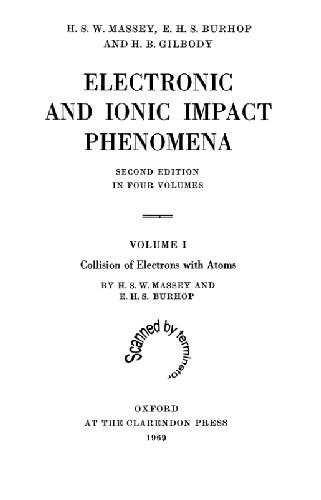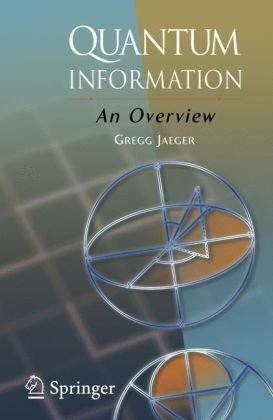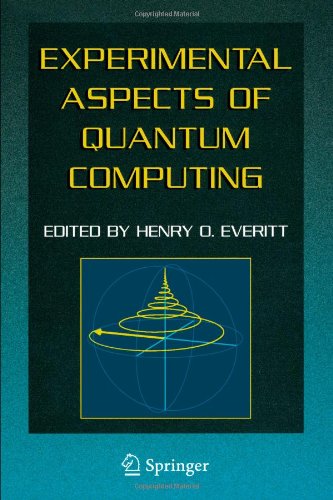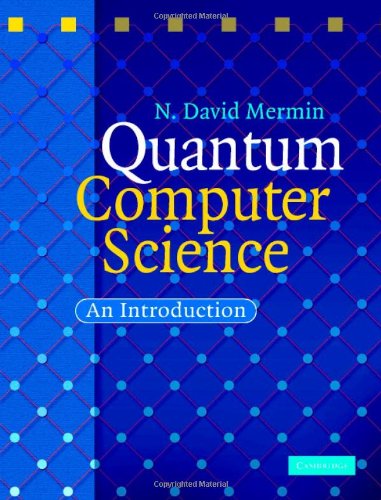Harrie Stewart Wilson Massey, E. H. S. Burhop9780198512479, 0198512473
Table of contents :
Title page ……Page 1
Date-line ……Page 2
PREFACE TO THE SECOND EDITION ……Page 3
PREFACE TO THE FIRST EDITION ……Page 5
ACKNOWLEDGEMENTS for VOLUMES I AND II ……Page 7
CONTENTS ……Page 9
1. Classification of collisions ……Page 19
2. The concept of collision cross-section ……Page 20
2.2. Differential cross-sections ……Page 23
3. Broad features and fine structure in the variation of cross-sections with electron energy ……Page 24
4.1. Ramsauer’s method ……Page 25
4.2. Measurement of collision cross-sections using atomic beams ……Page 27
4.2.1. Method depending on observation of scattered electrons ……Page 28
4.2.2. Method depending on observation of atomic beam attenuation ……Page 30
4.2.3. Method depending on observation of electron beam attenuation ……Page 35
5. Experimental methods for observation of the fine structure of total cross-sections ……Page 37
5.1. Use of spherical energy analyser ……Page 38
5.2. Use of the retarding potential difference method ……Page 39
6.1. Broad features of observed cross-sections ……Page 42
6.2.2. Atomic hydrogen ……Page 49
6.2.3. Helium ……Page 53
6.2.4. Neon ……Page 58
6.2.5. Argon, krypton, and xenon ……Page 59
6.2.6. Mercury ……Page 61
6.3. Summarizing remarks ……Page 62
1. Diffusion of electrons through gases ……Page 63
1.1. Momentum-transfer (diffusion) cross-section ……Page 65
1.2. The electron velocity distribution, drift, and random velocity ……Page 66
1.2.1. Proof of velocity distribution formula ……Page 67
1.3. The mean energy and drift velocity ……Page 70
2. Measurement of the characteristic energy of a diffusing swarm of electrons ……Page 71
3.1. The electrical shutter method ……Page 76
3.2. Hornbeck’s method ……Page 78
3.3. Use of proportional counters for drift velocity measurement ……Page 79
3.4. Errors in drift velocity measurements due to diffusion ……Page 80
3.5. Measurement of drift velocity in a glow discharge ……Page 82
4. Drift in combined electric and magnetic fields ……Page 83
5. Microwave afterglow methods for measuring momentum-transfer cross-sections for collisions with thermal electrons ……Page 85
5.1. Resonant cavity method ……Page 89
6. Cyclotron resonance method for measuring momentum-transfer cross-sections at very low electron energies ……Page 92
6.1. Effect of a magnetic field on the resonant frequency of a cavity containing plasma ……Page 96
7. Results of measurements of transport properties and their analysis in terms of momentum-transfer cross-sections ……Page 97
7.1. Results for helium ……Page 99
7.2. Results for neon ……Page 102
7.3. Results for argon, krypton, and xenon ……Page 105
7.4. Results for caesium ……Page 111
1. Introduction ……Page 115
2. The electrical measurement of ionization cross-sections ……Page 116
2.1. Measurement of the apparent total ionization cross-section ……Page 117
2.1.1. Measurement of the ion current, $i_+$ ……Page 118
2.1.3. Measurement of the electron path-length, $l$ ……Page 119
2.1.4. Measurement of the concentration, $N$, of scatterers ……Page 120
2.1.5. Reliability of ionization cross-section measurements ……Page 121
2.2. Analysis of positive ion current ……Page 122
2.3. The crossed-beam method for the measurement of total apparent ionization cross-section ……Page 124
2.4.1. Use of a high-resolution electron beam ……Page 130
2.4.2. The retarding potential difference method ……Page 132
2.4.3. Morrison’s method of studying fine structure in ionization cross -sections ……Page 134
2.4.4. Problems involved in experimental study of threshold behaviour ……Page 136
2.4.5. The use of crossed-beam methods for studying ionization near the threshold ……Page 137
2.5. Observed results—measurement of ionization cross-sections ……Page 141
2.5.2. The cross-sections for single and multiple ionization ……Page 143
2.5.3. Detailed structure in the form of variation of $Q_i$ with electron energy ……Page 145
2.5.3.1. The increase of ionization cross-section near the threshold ……Page 149
2.5.3.2. Fine structure of ionization cross-section near the threshold ……Page 152
2.5.3.3. Multiple ionization through the Auger effect ……Page 158
2.5.3.4. Production of metastable ions ……Page 159
3. The ionization of positive ions by electron impact ……Page 162
3.1.1. The crossed-beam method ……Page 163
3.1.2. The ion-trap method ……Page 167
3.2. Results of measurements of ionization cross-sections of positive ions ……Page 169
4.1. The experimental method ……Page 171
5. Inner-shell ionization of atoms by electron impact ……Page 176
5.1. The measurement of inner shell ionization cross-sections ……Page 178
5.2. Results of the measurements ……Page 183
5.3. Double inner-shell ionization ……Page 185
1.1. Principle of the method ……Page 187
1.2. Principles involved in absolute measurement of cross-sections—polarization of emitted radiation ……Page 189
1.3.1. Measurement of optical excitation functions ……Page 190
1.3.2. The measurement of the polarization of impact radiation ……Page 196
1.3.3. Measurements using gas or vapour in bulk ……Page 197
1.3.4. Crossed-beam methods ……Page 211
1.4.2. Results of measurements in helium ……Page 214
1.4.2.1. Optical excitation functions for electron energies greater than 35 eV ……Page 215
1.4.2.2. Optical excitation functions for electron energies less than 35 eV ……Page 225
1.4.2.3. Polarization ……Page 232
1.4.3. Results of measurements in mercury vapour ……Page 234
1.4.4.2. Alkali metals ……Page 241
1.4.4.3. Cadmium ……Page 245
1.5. Simultaneous ionization and optical excitation ……Page 246
2.1.1. Quenching of metastable states ……Page 249
2.1.2.1. Electron ejection from surfaces by metastable atoms ……Page 252
2.1.2.2. Detection of metastable atoms by ionizing collisions of the second kind ……Page 255
2.1.2.3. Detection of auto-ionizing metastable atoms ……Page 257
2.1.3. Methods combining quenching and direct detection of metastable atoms ……Page 260
2.1.4. Optical methods for measuring metastable atom production rates ……Page 263
2.1.4.1. The optical absorption method ……Page 264
2.1.4.2. The anomalous dispersion method ……Page 266
2.2.1. Excitation of the 2s metastable states of atomic hydrogen ……Page 268
2.2.2. Excitation of the metastable states of He ……Page 271
2.2.3. Excitation of metastable states of other inert gases ……Page 275
2.2.4. Excitation of the auto-ionizing (ls 2s 2p) $^4$P state of lithium ……Page 279
3.1.1. Superelastic collisions ……Page 281
3.1.2. Total cross-sections ……Page 285
3.2. Measurement of cross-section for excitation of He+ ions to the 2s state by an electron-ion crossed-beam method ……Page 288
2. Determination of excitation cross-sections from electron energy loss studies ……Page 295
2.1. Diffusion through a gas of electrons with energy sufficient to produce inelastic collisions ……Page 296
2.2. Measurement of excitation cross-sections by the diffusion method ……Page 298
2.3. The electron-trap method ……Page 302
2.4. Detection of superelastic collisions ……Page 306
3.1. Ionization and excitation coefficient ……Page 308
3.1.1. Measurement of the ionization coefficient ……Page 309
3.1.2. Study of microwave gas discharge breakdown ……Page 311
3.1.3. Measurement of drift velocity at large $F/p$ values ……Page 314
3.2. Calculation of the velocity distribution function when inelastic collisions are important ……Page 317
3.3.1. Application to helium ……Page 319
3.3.2. Application to other rare gas atoms ……Page 325
4. The energy loss of electrons scattered through a fixed angle ……Page 327
4.1. Methods of velocity analysis of the scattered electrons ……Page 328
4.2. Results of energy loss measurements ……Page 330
4.2.1. Resonances in inelastic scattering ……Page 334
5. Measurement of the angular distributions of the scattered electrons ……Page 339
5.1.1. The electron source ……Page 340
5.1.3. The analyser and collector ……Page 342
5.2.2. Scattering at $180^circ$ ……Page 346
5.2.3. Scattering at small angles ……Page 347
5.2.4. Scattering by metal vapours ……Page 349
5.3.1. Elastic scattering ……Page 350
5.3.2. Inelastic scattering ……Page 355
5.3.3. Excitation of resonant states—differential cross-sections ……Page 363
6. Spin polarization of electrons following elastic scattering ……Page 367
6.1. Measurement of the spin polarization of the scattered electrons ……Page 371
6.2. Results of the spin polarization measurements ……Page 373
7. Spin-exchange collisions ……Page 375
7.1. Atomic-beam method ……Page 376
7.2. Optical-pumping method ……Page 381
7.3. Use of spin-exchange collisions to produce a polarized electron beam ……Page 387
1. Subdivision of the theoretical problem ……Page 391
2.2. The Hartree and Hartree-Fock field of an atom ……Page 394
2.3. The statistical model ……Page 396
3.1. Total cross-section ……Page 397
3.2. Angular distribution of elastically scattered electrons—differential cross -section ……Page 399
3.3. Proof of quantum formulae ……Page 401
3.4. The variation of the phase shifts with energy and angular momentum ……Page 403
3.5. Effective range expansions for $k^{2l+1} cot eta_l$ ……Page 406
3.6. Relation of the phase shifts to number of bound states ……Page 408
3.7. ‘Classical’ approximation for the phase $eta_l$ ……Page 409
3.8. Variational methods for determining the phase $eta_l$ ……Page 411
3.9. Scattering by a Coulomb field ……Page 414
3.10. Scattering by a modified Coulomb field ……Page 417
4.1. The Ramsauer-Townsend effect ……Page 419
4.2. Similar behaviour of the heavier rare gases ……Page 423
4.4. Large cross-sections for alkali metals ……Page 425
4.5. Similarity of behaviour of chemically similar atoms ……Page 426
4.6. Angular distribution for scattering of low-energy electrons by rare gas atoms ……Page 428
5. Pressure shift of the high series terms of the alkali metals—relation to the elastic cross-section of the perturbing atoms for very low-energy electrons ……Page 432
6. Relativistic effects including spin polarization ……Page 436
1. Born’s approximation and the scattering of electrons by hydrogen atoms ……Page 444
2. Scattering by a helium ion—the Coulomb-Born approximation ……Page 446
4. Application to elastic scattering—angular distributions at high energy ……Page 447
5.1. The cross-sections for excitation and ionization ……Page 452
5.2.1. Optical transition probabilities and oscillator strengths and cross-sections ……Page 456
5.2.2. Sum rules for oscillator strengths ……Page 459
5.2.3. Alternative forms for the transition matrix element ……Page 461
5.2.4. Relation to Born’s collision theory ……Page 462
5.3.1. Excitation by a time-dependent perturbation ……Page 463
5.3.2. Excitation by a moving centre of force ……Page 465
5.3.3. Relation to Born’s approximation ……Page 466
5.3.4. Excitation of optically allowed transitions ……Page 468
5.3.5. Application to transitions between closely coupled states ……Page 470
5.4. Electron exchange ……Page 471
5.4.1. The Born-Oppenheimer approximation ……Page 472
5.4.2. Ochkur’s approximation ……Page 473
5.5. Theoretical limit to the magnitude of collision cross-sections ……Page 475
5.6.1. Excitation of atomic hydrogen ……Page 476
5.6.2. Ionization of atomic hydrogen ……Page 479
5.6.3. Relative probabilities of different types of collision ……Page 488
5.6.4. Atomic hydrogen—comparison with observation ……Page 489
5.6.5. Excitation and ionization of He+ and other hydrogen-like ions ……Page 490
5.6.6. Excitation of helium—calculated cross-sections ……Page 495
5.6.7. Excitation of helium—comparison with observation—optically allowed transitions ……Page 498
5.6.8. Ionization of helium ……Page 504
5.6.9. Excitation of optically forbidden transitions in helium ……Page 509
5.6.10. Summarizing remarks—the applicability of Born’s approximation to inelastic collisions in helium ……Page 512
5.6.11. Applications to other atoms and ions ……Page 513
5.6.12. Angular distribution of the totality of inelastically scattered electrons ……Page 516
5.6.13. Detachment of electrons from H- ions by electron impact ……Page 517
1. Introduction ……Page 519
2.1. The generalized variational method ……Page 520
2.2. The eigenfunction expansion ……Page 521
2.2.1. Analysis of elastic scattering in terms of phase shifts ……Page 522
2.2.2. The forward intensity of elastic scattering—dispersion relations ……Page 523
2.2.3. The truncated eigenfunction expansion approximation ……Page 524
2.3. Allowance for distortion of the atom by the incident electron—Temkin’s analysis of s-scattering ……Page 527
2.4. Allowance for distortion of the atom by the incident electron—the polarized-orbital and exchange-adiabatic approximations ……Page 528
2.6. Results obtained by various methods—the zero order phase shifts $eta_0^pm$ ……Page 532
2.7. The first and second order phase shifts $eta_1^pm$, $eta_2^pm$ ……Page 535
2.8. Comparison with observation ……Page 536
2.9. Dispersion relations and the elastic scattering of electrons by atomic hydrogen ……Page 537
3. Spin-exchange collisions ……Page 539
4.1. The generalized variational method ……Page 542
4.2. Distorted-wave method ……Page 543
4.3. The excitation of the 2s and 2p states of hydrogen ……Page 545
4.4. The excitation of the 2s-2p transition ……Page 549
4.6. Ionization ……Page 551
5.1. Elastic scattering below the excitation threshold ……Page 552
5.2. Excitation of 2s and 2p states of He+ ……Page 554
6. Collisions with helium atoms ……Page 556
6.1. Elastic scattering ……Page 557
6.2. Excitation of the 2-quantum states—elastic collisions with metastable atoms ……Page 567
7.1.1. Effective range analysis ……Page 571
7.1.2. Application of the exchange-adiabatic approximation ……Page 573
7.2. Angular distribution of inelastically scattered electrons—diffraction effects ……Page 576
8. Collisions with alkali metal atoms ……Page 578
8.1. Application of the s-p close-coupling approximation to elastic scattering ……Page 580
8.3. Excitation of the ns-np (resonance) transitions ……Page 586
9.1. Introductory ……Page 588
9.2. Collisions with neutral oxygen, carbon, and nitrogen atoms ……Page 592
9.3. Collisions with ionized atoms ……Page 595
9.4. Transitions between fine structure levels ……Page 598
10. The theory of the polarization of impact radiation ……Page 599
10.1. Inclusion of electron spin ……Page 601
10.2. Effects of nuclear spin ……Page 604
11. Classical theory and electron-atom collisions ……Page 605
9. RESONANCE PHENOMENA—THRESHOLD BEHAVIOUR ……Page 612
1. Resonance phenomena and auto-ionization ……Page 613
1.1. Perturbation theory involving the interaction of a discrete state and a continuum ……Page 615
1.1.1. Cross-sections for excitation of unbound states from the ground state ……Page 620
1.2. Interaction between one discrete state and two or more continua ……Page 622
1.2.1. Cross-sections for excitation of continuum states, of energy $E$, from the ground state ……Page 625
1.3. Extension to scattering of electrons with non-zero angular momentum ……Page 628
1.4. Variation of resonance parameters along a Rydberg series ……Page 629
2. Summary of resonance effects and qualitative comparison with experimental results in electron scattering by atoms ……Page 630
3. Accurate calculation of resonance parameters—relation to coupled equations ……Page 633
3.1. Application to the calculation of resonance energies and level widths associated with the doubly-excited states of helium based on the 2s and 2p states of He+ ……Page 637
3.2. Comparison with experiment ……Page 645
4. Resonance energies and level widths of doubly-excited states of H- ……Page 647
5. Resonance energies and level widths of doubly and triply excited states of He- ……Page 656
6. Doubly-excited states of Ne- ……Page 658
8. Doubly-excited states of Hg- ……Page 659
9. One-body or shape resonances ……Page 660
10.1. The two-channel S, T, R, and M matrices for states of zero angular momentum ……Page 663
10.2. Generalization to coupling between states of different angular momentum ……Page 671
10.3. Generalization to any number of channels ……Page 672
10.4. Modifications introduced by the presence of a Coulomb field ……Page 673
10.5. Generalization of the quantum-defect method to coupled channels ……Page 675
10.6. Threshold effects of orbital degeneracy ……Page 678
10.8. Threshold law for ionization ……Page 681
Separate sheet with Fig. 2.12 ……Page 683
Separate sheet with Fig. 3.5 ……Page 684
AUTHOR INDEX ……Page 685
SUBJECT INDEX ……Page 692







Reviews
There are no reviews yet.